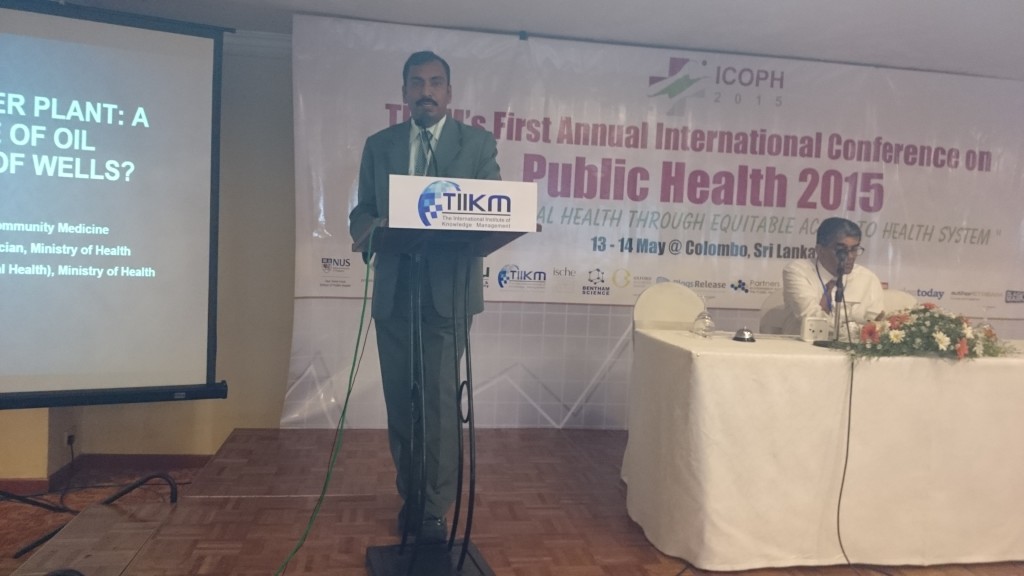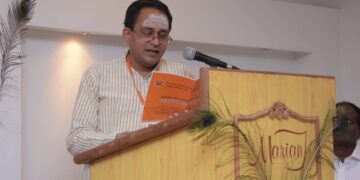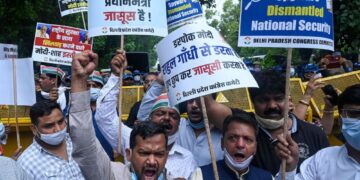 சுண்ணாகம் நீர் மாசடைதல் தொடர்பாக நடுவர்களினால் மீளாய்வுக்கு உட்படுத்தப்பட்ட முதலாவது ஆய்வுக் கட்டுரை சமுதாய மருத்துவ நிபுணராகவும் யாழ் மருத்துவச் சங்கத்தின் தலைவராகவும் செயற்பட்டு வரும் வைத்திய கலாநிதி முரளி வல்லிபுரநாதன் அவர்களினால் கொழும்பில் இடம் பெற்ற பொது சுகாதாரத்திற்கான 2015 சர்வதேச மகாநாட்டில் (International conference on Public Health ) இன்று வாசிக்கப்பட்டது . Dr .NWANY விஜயசேகர சமுதாய மருத்துவ பட்டப் பின் படிப்புப் பயிலுனர் , Dr முரளி வல்லிபுரநாதன் சமுதாய மருத்துவ நிபுணர், Dr HDB ஹேரத் சுற்றுச்சூழல் சுகாதாரத்திற்கான பிரதிப் பணிப்பாளர் ஆகியோரினால் இணைந்து ” சுண்ணாகம் மின்னுற்பத்தி நிலையம்: கிணறுகளில் எண்ணெய் மாசு கலந்து இருப்பதற்கான மைய மூலமா ? ” என்ற தலைப்பில் மேற்கொள்ளப்பட்ட ஆய்வு சர்வதேச ஆய்வாளர்கள் பலரது கவனத்தையும் இன்று ஈர்த்தது.
சுண்ணாகம் நீர் மாசடைதல் தொடர்பாக நடுவர்களினால் மீளாய்வுக்கு உட்படுத்தப்பட்ட முதலாவது ஆய்வுக் கட்டுரை சமுதாய மருத்துவ நிபுணராகவும் யாழ் மருத்துவச் சங்கத்தின் தலைவராகவும் செயற்பட்டு வரும் வைத்திய கலாநிதி முரளி வல்லிபுரநாதன் அவர்களினால் கொழும்பில் இடம் பெற்ற பொது சுகாதாரத்திற்கான 2015 சர்வதேச மகாநாட்டில் (International conference on Public Health ) இன்று வாசிக்கப்பட்டது . Dr .NWANY விஜயசேகர சமுதாய மருத்துவ பட்டப் பின் படிப்புப் பயிலுனர் , Dr முரளி வல்லிபுரநாதன் சமுதாய மருத்துவ நிபுணர், Dr HDB ஹேரத் சுற்றுச்சூழல் சுகாதாரத்திற்கான பிரதிப் பணிப்பாளர் ஆகியோரினால் இணைந்து ” சுண்ணாகம் மின்னுற்பத்தி நிலையம்: கிணறுகளில் எண்ணெய் மாசு கலந்து இருப்பதற்கான மைய மூலமா ? ” என்ற தலைப்பில் மேற்கொள்ளப்பட்ட ஆய்வு சர்வதேச ஆய்வாளர்கள் பலரது கவனத்தையும் இன்று ஈர்த்தது.
இந்த ஆய்வில் 2013-14 காலப் பகுதியில் தேசிய நீர் வழங்கல் வடிகாலமைப்பு சபையினால் மேற்கொள்ளப்பட்டு வெளியிடப்பட்ட ஆய்வு அறிக்கையில் உள்ள இரண்டாம் நிலைத் தரவுகள் மீளாய்வுக்கு உட்படுத்தப்பட்டது. சுண்ணாகம் மின்னுற்பத்தி நிலையத்தில் இருந்து கிணறுகளின் தூரம் அதிகரிக்கும் போது அவற்றில் உள்ள எண்ணெய் மாசுக்களின் செறிவு குறைந்து செல்வது உரிய புள்ளிவிபரவியல் பரிசோதனைகளுக்கு உட்படுத்தப்பட்டு விஞ்ஞான ரீதியாக சுண்ணாகம் மின்னுற்பத்தி நிலைய வளாகத்தில் இருந்து எண்ணெய் மாசுக்கள் நிலத்தடி நீரில் கலந்து சூழ உள்ள கிணறுகளைப் பாதிப்பது நிருபிக்கப் பட்டுள்ளது .
இந்த ஆய்வு ஆவணப் படுத்தப் படுவது சுண்ணாகம் மின்னுற்பத்தி நிலைய வளாகம் நிலத்தடியில் கலந்திருக்கும் மாசுக்கள் தொடர்பாக மேலதிக மேற்பார்வைக்கும் பரிசோதனைக்கும் உட்படுத்தப் பட வேண்டிய அவசியத்தை வலியுறுத்துவதுடன் இலங்கை மின்சார சபையையும் அதனால் பணியில் அமர்த்தப்பட்ட தனியார் மின்னுற்பத்தி நிறுவனத்தையும் சுற்றுச்சூழலுக்கு ஏற்படுத்தப்பட்ட சேதம் தொடர்பான பொறுப்புக் கூறலுக்கு வழிவகுத்துள்ளதுடன் பாதிக்கப்பட்டவர்கள் நட்டஈடு கோருவதற்கு முதற்படி ஆகவும் அமைந்துள்ளது .
இதுவரை இந்த விடயம் தொடர்பாக அமைச்சர் ஐங்கரநேசனின் நிபுணர் குழு உறுப்பினர்களினால் வெளியிடப்பட்ட ஆய்வுக் கட்டுரைகள் நடுவர்களினால் ஆய்வுத்திறன் தொடர்பான மீளாய்வுக்கு உட்படுத்தப்படவில்லை என்பதுடன் இந்த மாசடைதலுக்கு பொறுப்பானவர்கள் யார் என்பது தொடர்பாக எந்தக் கருத்தையும் தெரிவிக்கவில்லை என்பதுடன் நிலத்தடி நீரில் நச்சுத் தன்மையான பதார்த்தங்கள் காணப்படவில்லை என்று கூறும் கண்துடைப்பு அறிக்கைகளாக இருப்பதும் குறிப்பிடத்தக்கது.
இது தொடர்பாக மேலும் கருத்துத் தெரிவித்த வைத்திய கலாநிதி முரளி வல்லிபுரநாதன் 2013-14 காலப் பகுதியில் தேசிய நீர் வழங்கல் வடிகாலமைப்பு சபையினால் மேற்கொள்ளப்பட்டு நீதிமன்றத்தினால் நிர்பந்திக்கப்பட்டு வெளியிடப்பட்ட ஆய்வு அறிக்கையில் உள்ள விபரங்கள் பொது மக்களுக்கு உரிய முறையில் வெளிப்படுத்தப் படாது இருப்பது பொது மக்களைப் பாதிக்கக் கூடிய சமூக விரோதச் செயலாகும் என்று கூறினார்.
குறிப்பாக ஈய நஞ்சு கலந்து இருப்பதாக அறிக்கையில் குறிப்பிடப்பட்டு இருக்கும் கிணறுகளை தமது பதவிகளை தக்கவைப்பதற்காக பொறுப்பான அதிகாரிகள் வெளிப்படுத்தாமல் இருப்பதன் காரணமாக இன்று வரைக்கும் பொது மக்கள் ஈய நஞ்சு கலந்த நீரையே அறியாமல் பருகிக் கொண்டிருக்கிறார்கள் . இது பல்தேசியக் கம்பனியின் நலன்களைக் காப்பதற்காக தமிழ் இன அழிப்பிற்கு துணை போகும் செயல் ஆகும்.
Chunnakam Power Plant: A point source of oil contamination of wells?
NWANY Wijesekara, V Murali, HDB Herath
Introduction: It has been reported that the wells in Chunnakam area have been contaminated by oil. Effluents from Chunnakam Power Plant (CPP) have been suspected as the source of this pollution. An analysis conducted by the Regional Laboratory of the National Water Supply and Drainage Board, Jaffna (NWSDB, Jaffna) has determined the percentage of wells exceeding the Maximum Permissible Limit (MPL) of the Sri Lanka Standards 614, 1983 in three zones: within 200m, 200m to 500m and 500m to 2000m radius zones from the CPP (81% (n=67), 74% (n=42) and 51% (n=41). In addition, the mapping of the wells was also directing towards. Their analysis has demonstrated that the percentage of wells exceeding MPL was decreasing with distance from the power plant.
Objective: To determine whether the CPP could be a point source for this contamination.
Methods: The secondary data presented in the report of the (NWSDB, Jaffna) was used in this analysis. Two by two tables were developed by calculating the number above or below the MPL using the above results. The Chi Square Statistic (X2) with p value of 0.05 and Odds Ratio (OR) with 95% Confidence Interval (95% CI) between different zones were calculated.
Results: For the zones within 200m and 200m to 500m, X2 was 1.407 (p=0.05896), OR was 1.474 (95% CI 0.05896-3.685). For the zones 200m to 500m and 500m to 2000m, X2 was 4.525 (p=0.01671), OR was 2.684 (95% CI 1.069-6.741). For the zones within 200m and 500m to 2000m, X2 was 10.35 (p=0.0006491), OR was 3.956 (95% CI 1.672-9.359).
Conclusion and Recommendation: The percentage of well exceeding the MPL has shown a decrease with the distance from the CPP. There was no statistical significance between the proportion of wells exceeding MPL between within 200m and 200-500m (X2 =1.407, p=0.05896). This was evident from the OR as well (1.474, 95% CI 0.05896-3.685). This may be due to within 200m and 200m-500m zones being equally contaminated or being saturated. There was statistically significant decrease of number of wells with more than MPL from 200m-500m to 500m-200m zones and within 200m and 500m-2000m zones. For the above pairs of zones, the OR was 2.684 (95% CI 1.069-6.741) and 3.956 (95% CI 1.672-9.359) respectively. The level of oil contamination appears to be uniform up to 500m from the CPP. However, this appears to be decreasing from there onwards up to 2000m. This analysis favors a point source to be located within the CPP area.











